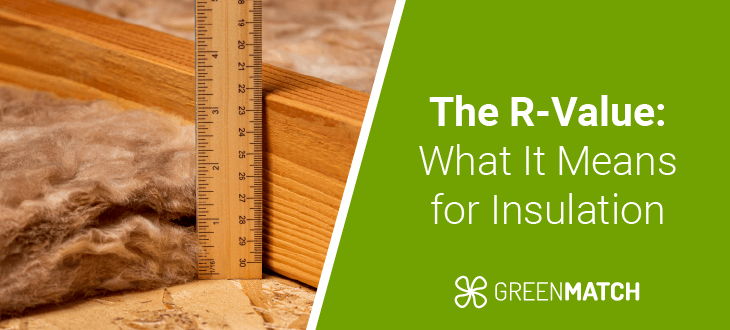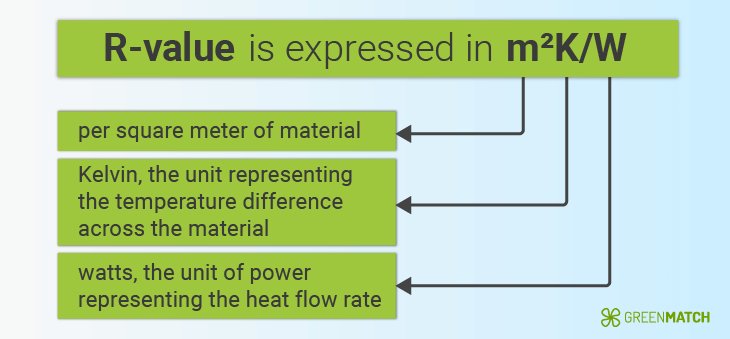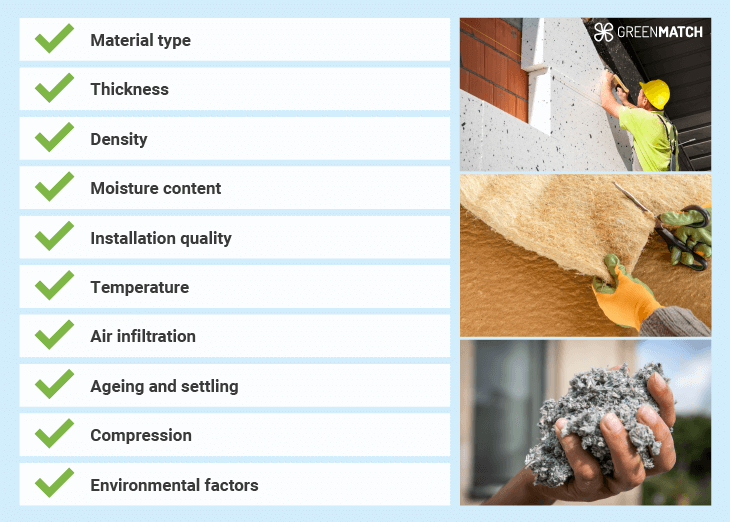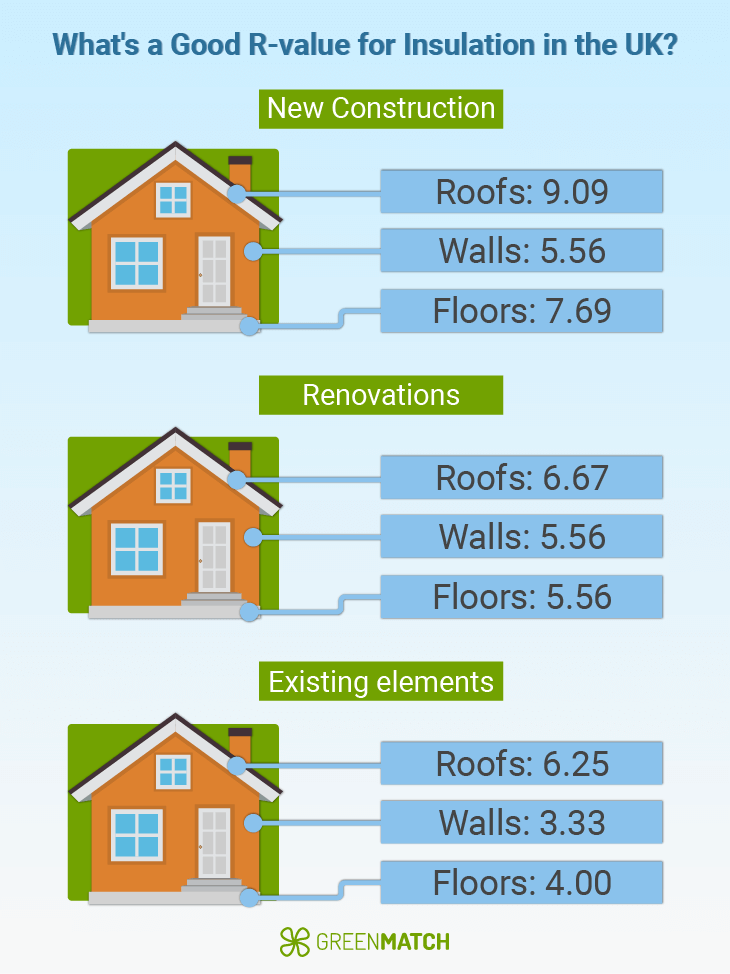Answer these simple questions and we will find you the BEST prices
Which type of solar quotes do you need?
It only takes 30 seconds
100% free with no obligation

Get Free quotes from insulation specialists near you

Save money by comparing quotes and choosing the most competitive offer

The service is 100% free and with no obligation
- GreenMatch
- Insulation
- R-value
R-Value for Insulation: Explanation, Best Ratings & Chart (2025)


- R-value measures an insulation material's ability to resist heat flow and is expressed in m²K/W.
- A good R-value depends on the specific application and climate, but generally, in the UK, it's 3.30 m²K/W for walls and 4.54 m²K/W for roofs.
- Phenolic boards, polyisocyanurate foam (PIR), and extruded polystyrene (XPS) are the top three materials with the best insulation values.
Dreading another winter of astronomical heating bills? Proper home insulation could be your key to a warmer and cheaper winter, saving you between £630 and £730 annually. And for the biggest savings, deciding on the right R-value insulation for your home is crucial.
Understanding the insulation value can significantly reduce your reliance on heating and cooling, saving you money year-round, all while improving your comfort of living.
In this article, you'll get the insulation R-value explained. We'll also break down the highest R-value insulation materials and answer the all-important question: "What is a good R-value for insulation in the UK?"
While our guide equips you with valuable knowledge, answering the question “What is R-value insulation?” on your own can take hours of strenuous research. This is why it’s best to ask a professional.
GreenMatch offers a convenient solution—simply fill in our 30-second form, and we’ll connect you with up to 3 vetted professionals near you. Our service is free and non-binding. Click below to begin!
- Describe your needs
- Get free quotes
- Choose the best offer
It only takes 30 seconds



- What does R-value for insulation mean?
- Benefits of using high R-value insulation materials
- What affects the R-value for insulation materials?
- R-value insulation chart in the UK
- R-values for typical insulation materials
- What is a good insulation R-value?
- Get insulation with the best R-value for your UK household
- FAQ
What does R-value for insulation mean?

The R-value measures thermal resistance used in the building and construction to rate the effectiveness of insulation materials. Simply put, it tells you how good an insulation material is at resisting the heat flow.
The higher the R-value, the better the insulation quality is.
The R-value of insulation is calculated by dividing the thickness of the material (in meters) by its thermal conductivity (lambda value, λ), and it is expressed in units of square meter Kelvin per watt (m²K/W).
For example, if you have a 15 cm (0.15m) thick layer of glass wool with lambda of 0.035 W/mK, its R-value is calculated the following way:
R= 0.15/0.035 ≈ 4.3 m²K/W
While the R-value is a universal concept, it's important to note that the specific ratings you'll encounter in the UK might be presented differently. Instead of R-values, UK insulation building regulations often focus on U-values for insulation.
But what is U-value insulation? Unlike R-rating insulation, it measures the rate of heat loss through a specific building element, like a wall or roof. Lower U values indicate better insulation performance and are expressed in W/m²K (Watts per square meter per Kelvin).
For instance, the external wall U-value requirement in new buildings in the UK is typically around 0.18 W/m²K, equivalent to an R-value of 5.56 m²K/W. The U-value for existing walls is 0.30 W/m²K with an R-value insulation equivalent of 3.33 m²K/W.
Benefits of using high R-value insulation materials

Beyond just keeping you warm, the best R-value insulation solution for your home offers you a multitude of advantages. Let's explore some of the key benefits:
- Saved costs: Loft, floor and wall insulation can bring you annual energy bill savings of £630–£730.
- Improved comfort: Insulation prevents drafts and hot spots, improves soundproofing, and maintains a stable indoor temperature.
- Reduced condensation: Insulation minimises the conditions that lead to condensation and dampness by maintaining a more consistent temperature and reducing thermal bridging (where heat escapes through less insulated building parts).
- Increased property value: Energy-efficient homes are more attractive to buyers, and the potential for lower energy bills can be a significant selling point.
- Energy efficiency: Proper home insulation can reduce a household's carbon emissions by up to 1.27 tonnes per year.
Also, important to note that insulated homes require less heating energy and lower energy consumption. This translates to fewer greenhouse gas emissions your household produces.
Selecting biodegradable, recycled, or renewable insulation options such as cellulose, fibre, and wood wool could reduce your carbon footprint even further.
The R-value varies among eco-friendly insulation materials. Therefore, it's important to consider both environmental impact and insulation performance when choosing a material. Let's take a closer look at the thermal resistance of the most common insulation materials.
What affects the R-value for insulation materials?

Not all insulation materials are created equal; some of them offer significantly better thermal resistance than others. Let's delve into the key factors that affect the R-value of materials used in insulation:
- Material type: Modern materials like polyisocyanurate (PIR) boards provide higher R-values than traditional options like mineral wool. Thus, thinner layers of PIR can achieve better insulation, which is particularly useful in space-constrained areas like loft conversions or cavity walls in older homes.
- Thickness: For loft insulation, choose a thicker layer of cheaper mineral wool. For wall cavities, a thinner layer of high-performance foam board might be more suitable.
- Density: Higher-density mineral wool batts provide better loft insulation than lower-density options, helping keep homes warm in winter and cool in summer.
- Moisture content: Insulation materials that absorb moisture, like some types of fibreglass, can lose a significant portion of their R-value. This is why proper vapour barriers and ventilation are essential in UK homes, especially in areas prone to condensation, like bathrooms and kitchens.
- Installation quality: Proper installation is essential for achieving the highest R-value for insulation. Gaps, compression, or improper fitting can reduce the R-value effectiveness.
- Temperature: Closed-cell spray foam insulation, such as Icynene, tends to maintain its R-value better in colder conditions, which is beneficial during UK winters. Conversely, materials like fibreglass may decrease the R-value slightly in warmer loft spaces during summer.
- Air infiltration: Older homes often suffer from draughts, which can undermine insulation performance. Using materials like airtight membranes and sealants around windows, doors, and service penetrations can help prevent air leakage and ensure the insulation performs as intended.
- Ageing and settling: Over time, some insulation materials, such as loose-fill cellulose, may settle or degrade, potentially reducing their R-value.
- Compression: Compressing insulation (e.g., squeezing two layers into a space meant for one) can reduce its effectiveness. While this may increase the insulation's R-value per unit of thickness, it generally decreases the total insulating performance of the material in the given space.
- Environmental factors: Exposure to UV radiation, chemical contaminants, or moisture can degrade some insulation materials over time, affecting their R-value. Materials like extruded polystyrene (XPS) and closed-cell spray foam are more moisture-resistant and can better maintain their R-value in humid conditions.
Understanding these factors and material options helps UK homeowners make informed decisions about insulation, ensuring energy efficiency, comfort, and compliance with local building regulations.
R-values for typical insulation materials
Let's explore the R-values of common insulation materials to help you choose the right one for your home.
| Material | Typical R-value (m²K/W) | Good for | Brands |
|---|---|---|---|
| Polyisocyanurate (PIR) boards | 3.6–4.5 | Walls, roofs, floors | Kingspan, Celotrex |
| Extruded polystyrene (XPS) | 2.6–3.6 | Areas prone to moisture like basements, external walls | Styrofoam, Jackodur |
| Expanded polystyrene (EPS) | 2.6–3.3 | Walls, roofs, floors | Jablite, Kay-Metzeler |
| Fiberglass batts | 3.0–4.0 | Lofts, walls | Knauf, Isover |
| Mineral wool batts | 2.5–3.3 | Lofts, walls, acoustic insulation | Rockwool, Knauf |
| Cellulose | 2.4–2.8 | Loft, walls, acoustic insulation, air infiltration, retrofitting | Warmcel, Greenfiber |
It's highly recommended to choose the materials together with an experienced insulation expert. Yet, with such a high demand for insulation, booking a meeting with qualified professionals can be a real challenge. Thankfully, GreenMatch can simplify the process of searches for you.
All you have to do is complete our 30-second form, and we’ll do the rest. You can then get up to 3 free and non-binding quotes and connect with our professional insulation installers network. This ensures that you can compare quotes from accredited suppliers. Click the button below to begin.
- Describe your needs
- Get free quotes
- Choose the best offer
It only takes 30 seconds



R-value insulation chart in the UK

Understanding the R-value is crucial, but with so many insulation options available, it can be tricky to know where to start.
In 2022, the UK government made significant updates to building regulations. They were aimed at improving energy efficiency and reducing carbon emissions in buildings. Among all, the updated Part L (Conservation of Fuel and Power) specifies minimum U-values for new constructions and renovations.
In the chart below, we provide the U-values along with their R-value insulation equivalents:
| Roofs | Walls | Floors | |
|---|---|---|---|
| U-values/R-values for new constructions | 0.11/9.09 | 0.18/5.56 | 0.13/7.69 |
| U-values/R-values for renovations | 0.15/6.67 | 0.18/5.56 | 0.18/5.56 |
| U-values/R-values for existing elements in existing dwellings | 0.16/6.25 | 0.30/3.33 | 0.25/4.00 |
As a homeowner, you should be aware of these requirements and consider the long-term benefits of proper insulation. However, with the new regulations coming in October 2024, it's best to consult a local insulation expert regarding any updated requirements.
What is a good insulation R-value?
Above, we've provided general R-value requirements for the most optimal results. Yet, what is a good R-value for insulation in the UK? A good R-value for insulation is generally considered to be around 4.15 m²K/W. For optimal performance, aim for R-values above 4.54 m²K/W, especially for roof insulation.
The recommended insulation values for different building parts depend on the specific application and local climate conditions. Here are some general guidelines:
| Element | Insulation R-value (m²K/W) |
|---|---|
| External walls | 2.29–3.70 |
| Basement walls | 1.94–2.64 |
| Roofs | 5.28–6.87 |
| Floors | 2.29–5.28 |
| Ceilings | 3.35–6.69 |
The choice of insulation material and thickness depends on the building's specific requirements, local climate conditions, and building regulations.
Get insulation with the best R-value for your UK household
Selecting the right R-value for insulation is essential for achieving energy efficiency, comfort, and compliance with building regulations.
In the UK, aiming for R-values around 3.30 m²K/W for walls and above 4.54 m²K/W for roofs is advisable. Always consider the specific requirements of your building and consult local building codes to ensure optimal insulation performance.
By understanding and choosing the appropriate R-values, you can significantly improve your home's thermal performance, reduce energy consumption, and slash your energy bills.
And for long-term savings, you must choose R-value insulation options that fit your home. An experienced professional can help you with that. However, finding a trustworthy expert in your area can drag on for days, if not weeks. A busy homeowner like you doesn't have so much time to spare!
Thankfully, GreenMatch can do the legwork for you. Fill out our 30-second form to get up to 3 quotes from our extensive network of vetted insulation professionals. No hidden fees or obligations to accept any offers. Simply click the button below to receive free quotes to compare.
- Describe your needs
- Get free quotes
- Choose the best offer
It only takes 30 seconds



FAQ
The higher the R-value, the better. For exterior walls, typical recommendations are 5.56 m²K/W. Common R-values for ceilings range from 3.35 to 6.69. Consult an insulation expert for advice tailored to your situation.
No, an R-value of 2.25 is generally considered low for most home insulation applications. It would not meet the recommended levels for any part of a house in most climate zones.
Insulation R-value can’t be “too high” regarding thermal performance. Higher R-values always provide better insulation. However, there can be practical and economic limits to increasing R-value. At a certain point, the additional cost of increasing insulation thickness may outweigh the energy savings benefits.
The “R” in the R-value stands for “resistance.” It measures a material’s ability to resist heat flow and is expressed in units of square meter Kelvin per watt (m2K/W).
We strive to connect our customers with the right product and supplier. Would you like to be part of GreenMatch?

- What does R-value for insulation mean?
- Benefits of using high R-value insulation materials
- What affects the R-value for insulation materials?
- R-value insulation chart in the UK
- R-values for typical insulation materials
- What is a good insulation R-value?
- Get insulation with the best R-value for your UK household
- FAQ
